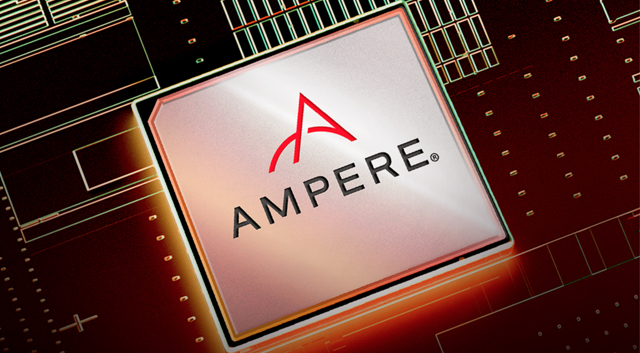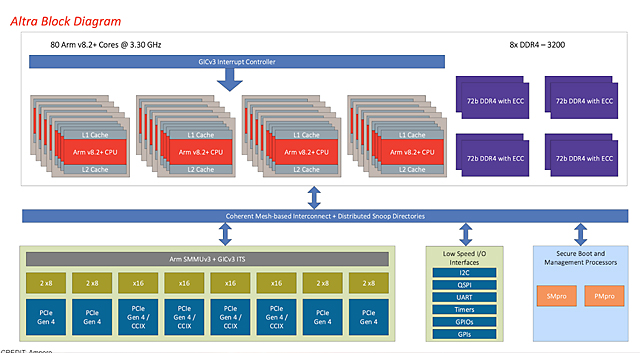Back to all articles
Ampere Altra CPUs: ARM For The Data Center?
Published: 12-5-2022

ARM CPU architecture has taken the mobile computing world by storm, and now it even powers Apple desktop and laptop computers. ARM CPUs are known for being power efficient, but now they’ve also developed a reputation for performance, so why not use them in data centers?
That’s the idea behind Ampere’s Altra processors, which offer a fascinating look at what’s possible when you build a data center CPU using ARM instead of x86-64 processors.
Altra’s Architecture

Each Altra has 80 Arm v8.2 cores, with a maximum clock speed of 3.3GHz. Perhaps more importantly, each individual core has its own dedicated L1 and L2 cache. They’re also single-threaded, so each core should perform consistently without bandwidth-sharing competition with other cores.
This is further bolstered by a high-performance mesh network connecting 32 nodes that each, in turn, connect a cluster of cores to the overall on-chip network.
Each socket offers 128 lanes of PCIe 4.0, with a dual socket configuration topping out at 196 lanes. This is great for massive bandwidth aimed at storage and network connectivity.
Similarly, each socket can address up to 4TB of DDR4-3200. So we’re talking about a serious amount of data that can be shifted around.
There’s also the Ampere Altra Max, which increases the core count to 128, while only suffering a 10% clock speed cut in return.
The Big Question: Power
Based on the paper specifications of the Altra, there’s little doubt that there’s a lot of usable processing power on offer here, but there’s no lock of that with x86 server systems either, especially with next-generation CPUs such as AMD’s amazing Zen 4 Genoa Epyc CPUs. The AMD chip also has nearly 100 cores and will soon push that to 128 cores with the release of Zen 4c.
Ampere claims that the Altra CPUs are the most power-efficient solution compared to x86 performance equivalents, and independent testing seems to indicate that these chips can be as much as twice as efficient compared to an x86 CPU with similar performance. However, the Altra Max’s 128-core TDP of 250W is essentially in the same range as something like Epyc Genoa.
Under real-world load conditions, we expect that the Altras will offer a significant power saving for the same performance, which should be music to the ears of anyone running a data center.
The x86 Elephant in the Room
Of course, one huge issue is that most software is written for the x86 processors that currently dominate in data centers. However, Ampere markets Altra chips as cloud-native CPUs running software written specifically for them. Unlike the desktop computing world, it’s easy to justify recompiling and porting software for ARM in the data center, especially if you’re using those processors for tasks such as AI or data mining, rather than providing VMs to end-users through the cloud.
Is ARM The Future?ARM technology is about the same age as x86 technology but has always lagged behind in pure performance. There’s significant debate about whether ARM really is more
power efficient thanks to its instruction set, or whether its simply because ARM licenses made it easy for mobile hardware makers to design their own chips with a focus on power efficiency.
In an alternative reality, it might have been the x86 license that was easy to get and installed in mobile devices worldwide. In this reality, that role fell to ARM, and now chips based on this architecture are just as fast as x86 cores, while using less power and producing less heat.
There are many predictions that see ARM eating a significant piece of the x86 pie in every area of computing, and we think data centers will be no different.